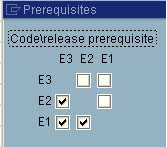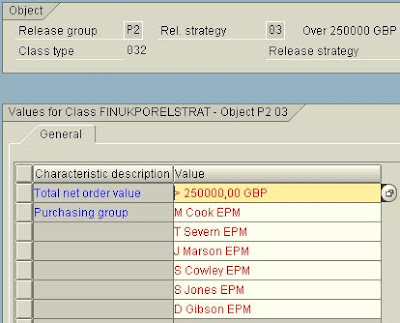![]() x Define Release Procedure for Purchase Orders
x Define Release Procedure for Purchase Orders
In this step, you set up the release procedure for purchase orders (POs) and can link it to workflow. (Note that in this context "releasing" means "approving", or giving the "green light" to a document.)
Requirements
x In the case of a release procedure linked to workflow, you must have previously created the user names, positions, jobs, etc. that you here assign to the release code in the organizational plan and must have linked them to the relevant standard tasks in task-specific Customizing (Basis -> Business Management -> Business Workflow -> Perform Task-Specific Customizing).
x You must assign the authorization M_EINK_FRG to the persons who are to be involved in the release procedure (Authorization Management -> Create Authorization Profiles and Assign to Users).
Activities
Here you define the following:
x Release group
x Release codes
x Release indicator x Release strategy x Workflow
Release group
Create a release group for your release procedure and assign it to a class. In the process, you assign
release conditions to the release procedure.
Release codes
Here you create the release codes you need for your release strategy and assign the codes to your release group. If a release code is to be used in workflow, indicate this accordingly in the Workflow field
The Workflow indicator is also used to control role resolution:
x "1 - Role Resolution with Group, Code and Plant (T16FW)"
Here you use a role resolution that is supplied in the standard system. To do so, you must assign the release point in the section Workflow (see below).
x "9 - Role Resolution via User Exit"
Here you use the customer exit M06E0005 to define a role resolution of your own.
Release indicators
A release indicator shows the release status of a PO.
Via the following settings, you can define the release indicators you need for your release procedure:
x The Released indicator is used to specify whether messages (PO documents in output format)
may be transmitted for a purchase order with this indicator.
x The Changeability indicator shows the effect of changes to the PO (a change to a PO may require a new release strategy to be determined, for instance).
x By means of the Value change indicator, you can specify that the release strategy is to be re- started if a PO is changed and the value of a PO item thereby increases by a certain percentage (e.g. 10%). Set the Changeability indicator to "4 - Changeable, new release in case of new strategy or value change" or "6 - Changeable, new release in case of new strategy or value change/outputted" and enter a percentage in the Value change field.
Attention:
The following release indicators are necessary for every release procedure:
o Release indicator for initial status
If the PO is subject to a release strategy, it must normally be released before it can be
transmitted to the vendor. Therefore, when a PO is created, it is assigned a release indicator that blocks it from being outputted in message form.
The Released indicator mustnot be selected for this indicator.
o Release indicator for released status
This indicator is assigned to the PO when it is released.
The Released indicator must be selected for this indicator.
Release strategies
Create a release strategy for your release group and assign your release codes accordingly.
x Release prerequisites
With the release prerequisites, you specify the order in which the individual release points (individuals or departments) represented by the release codes may release the document. Example
![]()
![]()
![]()
![]() The following table shows release prerequisites for a strategy with four release codes. Code/Release prerequisite
The following table shows release prerequisites for a strategy with four release codes. Code/Release prerequisite
|
|
| 01 | 02 | 03 | 04 |
|
| 01 | - | [ ] | [ ] | [ ] |
|
| 02 | [x] | - | [ ] | [ ] |
|
| 03 | [x] | [x] | - | [ ] |
|
| 04 | [x] | [x] | [x] | - |
In this release strategy, the codes 01, 02, 03, and 04 must successively release the purchase order.
Read the table from left to right. For instance, the third line for release code 03: For code 03,
release via code 01 and code 02 is a prerequisite. That is to say, the PO must be released via codes 01 and 02 before it can be released via code 03.
x Release statuses
Here you specify the status a PO has after certain release points have effected release. Specify which release indicator/status a PO is to have after having been released via a certain release code.
x Classification
In classification, you maintain the values assigned to the characteristics. Via the characteristics and their values, you specify the POs to which your release strategy is assigned.
Maintain values (individual values or intervals) for your characteristics.
Example
Two characteristics and their values have been maintained in classification for release strategy
'EA':
- Document type - 'NB - standard purchase order'
- Total value - above $10,000
All POs with the document type 'NB' and a total value in excess of $10,000 are thus subject to a release procedure with the release strategy 'EA'.
x Release simulation
The release simulation function enables you to check which status a PO will achieve with your release strategy if release is effected by a certain release point.
Choose "Simulate release" and release the document with the desired release code by double- clicking. The system shows you which status the PO now has as a result of this release.
Workflow
Assign a processor ID to your workflow-relevant release codes. The processor (member of staff responsible for processing the document) will then receive a work item when he or she is required to effect release.
You can assign a processor ID either directly or indirectly:
o Direct processor assignment: Enter a user name.
o Indirect processor assignment:
Enter a job, for example, or a position. At runtime, the system will then determine the member(s) of staff responsible for processing the document.
Customer exit
 Customer exit M06E0005 enables you to define your own role resolution which determines the person responsible for releasing purchasing documents in workflow.
Customer exit M06E0005 enables you to define your own role resolution which determines the person responsible for releasing purchasing documents in workflow.









No comments:
Post a Comment